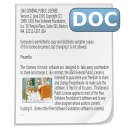Análisis de sentimiento en Twitter en relación a la tecnología IA para generación de imágenes
Resumen
El avance en la tecnología de inteligencia artificial (IA) ha llevado a mejoras significativas en la generación de imágenes en términos de velocidad y calidad. Sin embargo, se ha generado preocupación e incertidumbre entre los artistas, quienes temen ser reemplazados por la IA en su campo de trabajo. En este contexto, se tuvo como objetivo el análisis de los Tweets donde se define el impacto de la inteligencia artificial (IA) en la adopción de tecnologías de generación de imágenes. Para ello, se llevó a cabo la recopilación, creación y evaluación de una red neuronal convolucional que clasifique los datos según un análisis de sentimiento entre positivo y negativo. Finalmente, la investigación se determinó la tasa de pérdida de un 63%, la precisión con un 61% y la curva ROC alrededor de un 64% de una red neuronal convolucional para la predicción de Tweets.
Descargas
Citas
Kalluri, S (2023). Deep Learning Based Sentiment Analysis. Faculty of Faculty, Blekinge Institute of Technology, Karlskrona,Sweden. https://www.diva-portal.org/smash/get/diva2:1741487/FULLTEXT02.pdf
Paredes-Valverde, M. A., Colomo-Palacios, R., Salas-Zárate, M. D. P. & Valencia-García, R. (2017). Sentiment Analysis in Spanish for Improvement of Products and Services: A Deep Learning Approach. Scientific Programming, 2017. https://doi.org/10.1155/2017/1329281 DOI: https://doi.org/10.1155/2017/1329281
T. Mikolov, I. Sutskever, K. Chen, G. Corrado, and J. Dean, "Distributed representations of words and phrases and their compositionality," in Proceedings of the 27th Annual Conference on Neural Information Processing Systems (NIPS '13), pp. 3111-3119, December 2013.
A. Severyn and A. Moschitti, "UNITN: training deep convolutional neural network for twitter sentiment classification," in Proceedings of the 9th International Workshop on Semantic Evaluation (SemEval '15), pp. 464-469, 2015.
A. Severyn and A. Moschitti, "UNITN: training deep convolutional neural network for twitter sentiment classification," in Proceedings of the 9th International Workshop on Semantic Evaluation (SemEval '15), pp. 464-469, 2015. DOI: https://doi.org/10.18653/v1/S15-2079
A. Zhang, L.; Wang, S.; Liu, B. Deep learning for sentiment analysis: A survey. WIREs Data Min. Knowl. Discov. 2018, 8, e1253.
Kraus, M.; Feuerriegel, S. Sentiment analysis based on rhetorical structure theory: Learning deep neural networks from discourse trees. Expert Syst. Appl. 2019, 118, 65-79. DOI: https://doi.org/10.1016/j.eswa.2018.10.002
Ain, Q.T.; Ali, M.; Riaz, A.; Noureen, A.; Kamran, M.; Hayat, B.; Rehman, A. Sentiment analysis using deep learning techniques: A review. Int. J. Adv. Comput.Sci. Appl. 2017, 8, 424 DOI: https://doi.org/10.14569/IJACSA.2017.080657
N. F. F. Da Silva, E. R. Hruschka, and E. R. Hruschka, "Tweet sentiment analysis with classifier ensembles," Decision Support Systems, vol. 66, pp. 170-179, 2014. DOI: https://doi.org/10.1016/j.dss.2014.07.003
T. Mikolov, I. Sutskever, K. Chen, G. Corrado, and J. Dean, "Distributed representations of words and phrases and their compositionality," in Proceedings of the 27th Annual Conference on Neural Information Processing Systems (NIPS '13), pp. 3111- 3119, December 2013.
Britz, D. Recurrent Neural Networks Tutorial, Part 1-Introduction to Rnns. https://dennybritz.com/posts/wildml/recurrent-neural-networks-tutorial-part-1/
M. del Pilar Salas-Zarate, M. A. Paredes-Valverde, J. Limon- ´ Romero, D. Tlapa, and Y. Baez-Lopez, "Sentiment classification of Spanish reviews: an approach based on feature selection and machine learning methods," Journal of Universal Computer Science, vol. 22, no. 5, pp. 691-708, 2016.
P. Smith and M. Lee, "Cross-discourse development of supervised sentiment analysis in the clinical domain," in Proceedings of the 3rd Workshop in Computational Approaches to Subjectivity and Sentiment Analysis, pp. 79-83, 2012.
Mikolov, Tomas, Kai Chen, Greg Corrado, and Jeffrey Dean. "Efficient estimation of word representations in vector space." arXiv preprint arXiv: 1301.3781 (2013). https://doi.org/10.1145/3388218.3388229 DOI: https://doi.org/10.1145/3388218.3388229
Djoerd Hiemstra. 2000. A probabilistic justification for using tf× idf term weighting in information retrieval. International Journal on Digital Libraries 3, 2 (2000), 131-139. DOI: https://doi.org/10.1007/s007999900025
M. Cliche, "BB twtr at SemEval-2017 Task 4: Twitter Sentiment Analysis with CNNs and LSTMs," Apr. 2017. DOI: https://doi.org/10.18653/v1/S17-2094
M. D. P. Salas-Zarate, R. Valencia-Garc ´ ´?a, A. Ruiz-Mart´?nez, and R. Colomo-Palacios, "Feature-based opinion mining in financial news: an ontology-driven approach," Journal of Information Science, 2016. DOI: https://doi.org/10.1177/0165551516645528
Z. Wang, H. Wang, Z. Liu & J. Liu, "Rolling Bearing Fault Diagnosis
Using CNN-based Attention Modules and Gated Recurrent Unit", Global Reliability and Prognostics and Health Management 7(2020) 6.
Umarania, V., Juliana, A., & Deepab, J. (2023). Sentiment Analysis using various Machine Learning and Deep Learning Techniques. Journal of Computational Intelligence, 7(3), 245-260. https://doi.org/10.46481/jnsps.2021.308 DOI: https://doi.org/10.46481/jnsps.2021.308
S. Md and S. Krishnamoorthy, "Student performance prediction, risk analysis, and feedback based on context-bound cognitive skill scores,"Educ. Inf. Technol., vol. 27, no. 3, pp. 3981-4005, 2022, doi: 10.1007/s10639-021-10738-2. DOI: https://doi.org/10.1007/s10639-021-10738-2
D. Tang, F. Wei, B. Qin, T. Liu, and M. Zhou, "Coooolll: A Deep Learning System for Twitter Sentiment Classification," in Proceedings of the 8th International Workshop on Semantic Evaluation (SemEval '14), pp. 208-212, Dublin, Ireland, 2014. DOI: https://doi.org/10.3115/v1/S14-2033
Bhavitha, B.; Rodrigues, A.P.; Chiplunkar, N.N. Comparative study of machine learning techniques in sentimental analysis. In Proceedings of the 2017 International Conference on Inventive Communication and Computational Technologies (ICICCT), Coimbatore, India, 10-11 March 2017; pp. 216-221. DOI: https://doi.org/10.1109/ICICCT.2017.7975191
Zhang, L.; Wang, S.; Liu, B. Deep learning for sentiment analysis: A survey. WIREs Data Min. Knowl. Discov. 2018, 8, e1253. DOI: https://doi.org/10.1002/widm.1253
Sohangir, S.; Wang, D.; Pomeranets, A.; Khoshgoftaar, T.M. Big Data: Deep Learning for financial sentiment analysis. J. Big Data 2018, 5, 3 DOI: https://doi.org/10.1186/s40537-017-0111-6
D. Britz, "Understanding Convolutional neural networks for NLP," in WildML, WildML. http://www.wildml.com/2015/11/understanding-convolutional-neural-networks-for-nlp/
Derechos de autor 2024 Innovación y Software

Esta obra está bajo licencia internacional Creative Commons Reconocimiento 4.0.
Los autores ceden en exclusiva el derecho de publicación de su artículo a la Revista Innovación y Software, que podrá editar o modificar formalmente el texto aprobado para cumplir con las normas editoriales propias y con los estándares gramaticales universales, antes de su publicación; asimismo, nuestra revista podrá traducir los manuscritos aprobados a cuantos idiomas considere necesario y difundirlos en varios países, dándole siempre el reconocimiento público al autor o autores de la investigación.
























